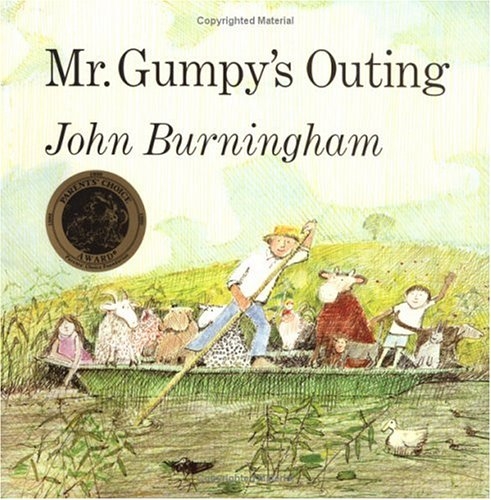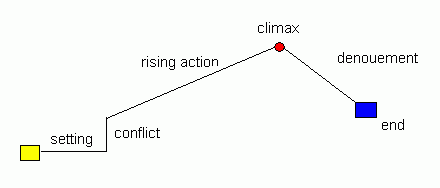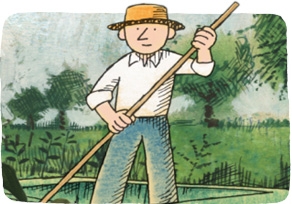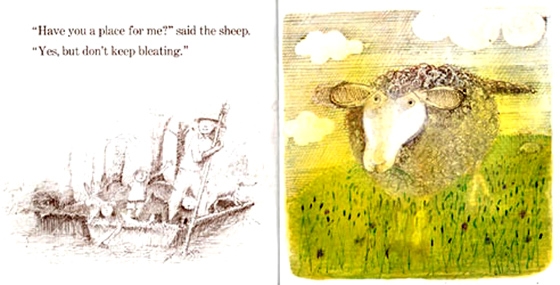1) Types of Characters: 1) Types of conflicts: On each side of the page, there is a colorful picture on the right, which is usually an animal related to the text on the left, and a black-and-white sketch on the left, which shows what is happening right now. The sketches are done with lots of lines to show shadows and the colorful illustrations are shown by colored pen and oil paintings. The facial expression for Mr. Gumpy, the children, and the animals is vivid and makes readers easily imagine the situation after each hop-in. Bravo! Gentle and rhyming texts reveal that John Burningham deliberately creates the humor by conceiving the personalities kids own. My favorite part is the last few pages – everyone falls into the water because they do not have the appropriate behaviors and then Mr. Gumpy says, “We’ll walk home across the fields.” A not angry at all Mr. Gumpy comforts everyone with his gentle soul to eliminate their anxiety and confusion. Well done! He does not obey the conventional thought – some stories books published in Taiwan have never made up a story without telling people what to do. In this situation, the sentences like “Oh! This is too dangerous! Everyone in the boat must obey the rules. It will be safer if you all promise me to follow what I say” will be replaced in the text. In my opinion, the writers should try not to struggle with putting the suitable lines in the story, sometimes they could just leave some imagination space for readers to shape their own stories. Therefore, not only do the readers enjoy the moment sharing their ideas, but the writers could avoid placing their entire original techniques into one book which leads nothing creative in their next publishing books.
The 1970 Kate Greenaway Medal,
1971 ALA Notable Children's Book Award,
The 1972 Boston Globe/Horn Book Award for Illustration

![]()
![]()
![]()
![]()

Summary
Mr. Gumpy, a nice man who owns a boat and lives nearby a river, sets off on a boat outing on a nice sunny day. Soon after he goes out in his boat, he has his company: first a boy and a girl, then the rabbit, the cat, the dog, the pig, the sheep, the chickens, and still others until the boat gets really full. Mr. Gumpy asks each creature for proper behaviors: the rabbit is told not to hop, the cat not to chase the rabbit, the dog not to tease the cat, the pig not to muck about, the sheep not to bleat, the chickens not to flap, the cow not to trample things, and the goat not to kick. All goes well, until the goat kicks and the others do the inappropriate behaviors which Mr. Gumpy tells them not to do earlier. Finally, the boat tips. In this moment, Mr. Gumpy, being gentle and kind, tells everyone to swim to the shore, serves them nice tea and even announces them to come for a ride another day.
Analysis
Characters
Protagonist (hero): Mr. Gumpy
Antagonist (villain): a boy and a girl, the rabbit, the cat, the dog, the pig,
the sheep, the chickens, the cow, and the goat
Setting
1) Type of setting: Backdrop Setting
Narrative Point of View
External Subjective Narrator (the 3rd person point of view)

Conflict
The Protagonist against Another
*Mr. Gumpy tells all the people and animals not to behave badly.
The Protagonist against Nature
*Mr. Gumpy puts so much weight in the boat, but it does not sink.
*Mr. Gumpy asks all the passengers not to do the things they normally do.
the sound "ee": Gumpy, happily, very, we, me, tease, please, sheep,
keep,bleating, fields, tea
the sound "i-e": by, dry, I, I'd, like, ride, while, climbed, time
the sound "o-e": owned, boat, don't go, home
the sound "ow": house, out, about
vowel + e : come, ride, chase, take, take, place, make, home, time, while
First, John Burningham's attitude toward the subject and the audience in this book is gentle and comforting. For instance, after the boat tips, Mr. Gumpy is not mad at all. He tells them to walk home across the fields and even offers them nice tea instead of using condemnable utterance. Second, during more and more creatures asking to join his outing, As the ride continues, Mr. Gumpy gently tells them to hop in but - don't squabble, hop, chase, tease, muck, bleat, flap, trample and kick. The implication of didactic utterance perfectly places in the boat travel. 
Details
Illustration

Reflection
- 5月 06 週二 200821:35
Mr. Gumpy's Outing
Parent's Choice Award 1990,
Plot
1) Type of plot structure:
A Progressive or Dramatic Plot: First establishes the setting (Mr. Gumpy goes out in his boat) and conflict (A boy and a girl want to join him.), then follows the rising action (All the other animals want to join, too.) through to a climax (The boat tips over because they don't behave appropriately), and concludes with a denouement (Everyone swims to the shore and has tea together.).
Theme
The thematic issue in “Mr. Gumpy's outing” is about Mr. Gumpy and his animal friends learn what happens in an overcrowded boat and how Mr. Gumpy deals with this situation with his kind soul - not having things get you down, even if it does not go your way.
Tone
Diction
"Mr. Gumpy's Outing" is a rhymetic storybook using multiplicate words to create the dialogue between Mr. Gumpy and other creatures. Instead of using the word - argue, John Burningham utilizes squabble so as to rhyme with the word - trample. Here are so other examples which can also be good for teaching kids phonetics.
Image
With different forms of inquiry from the passengers who are interested in joining the boat travel, the whole story becomes more educational for readers. (May we come with you? / May I come along? / I'd like a ride./ Will you take me with you? / May I come, please? / Have you a place for me? / Can you make room for me? / May I join you? )
Language
The simple and repeated dialogue that the author makes help the readers follow the story easiler and don't get puzzled with all these creatures showing in the story. Each character becomes alive through his action and speechwithout description.
文章標籤
全站熱搜
